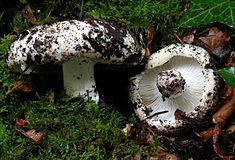- Russula delica
-
Russula delica 
Conservation status Common / safeScientific classification Kingdom: Fungi Division: Basidiomycota Class: Agaricomycetes Order: Russulales Family: Russulaceae Genus: Russula Species: R. delica Binomial name Russula delica
Fr.Russula delica Mycological characteristics 
gills on hymenium 

cap is convex
or depressed
hymenium is decurrent 
stipe is bare 
spore print is white 
edibility: edible Russula delica is a mushroom that goes by the common name of milk-white brittlegill, and is a member of the Russula genus, all of which are collectively known as brittlegills. It is mostly white, with brownish cap markings, and a short robust stem. It is edible, but poor in taste, and grows in mixed woods, in autumn. It can be confused with certain white Lactarius species.
Contents
Taxonomy
First described by the Swedish mycologist Elias Magnus Fries in 1838, its specific epithet delica is Latin for "weaned".[1] Older names include Christian Hendrik Persoon's Lactarius piperatus var. exsuccus.
This species has seen many taxonomic changes over the years. Many variants, and species have been separated from the true form, for various and myriad reasons. Notably Russula chloroides is given species status by some authorities, because of the narrow blue/green zone at the stem apex of some specimens.[2] Gill spacing, and gill depth has also thrown many finds into doubt, in the past.
Mycologist John Burton Cleland collected a form he described in 1935 as R. delica from under eucalypts in the Mount Lofty Ranges in South Australia,[3] however, this was reclassified as a new species R. marangania in 1997 by Cheryl Grgurinovic.[4]
Description
The basidiocarps (fruiting bodies) of Russula delica seem loath to leave the soil, and are often found half buried. As a result, the caps often traps the surrounding leaf debris on their rough surfaces. The cap can be 16 cm (6.3 in) in diameter. It is white, usually tinged with ochre or brown, with an inrolled margin, which usually remains white. At first it is convex, but later flattens, and is often funnel shaped. The firm, white stipe is short and stout, measuring 2–6 cm (0.8–2.4 in) high and 2–4 cm (0.8–1.6 in) wide. The gills are decurrent, and are quite closely spaced initially. The spore print is creamy white, and the warty oval spores measure 8–12 x 7–9 μm. The flesh is white, and does not change colour on cutting. The flesh may smell faintly of fish or insects, and has a hot, bitter, tangy taste.[5]
Similar whitish Lactarius species, such as L. piperatus all exude milk from the gills, and the cut flesh.[6]
Distribution and habitat
Russula delica is widespread in the northern temperate zones, including Britain, Europe, Asia.[5] In North America Russula delica is rare, and is largely replaced by R. brevipes,[7] which is very similar, and is not on the British list.
A common mushroom, it appears in autumn in deciduous and coniferous woods, and forests.[5]
Edibility
This mushroom is edible, but poor, having an unpleasant taste,[5] leading some to classify it as inedible.[1]
See also
References
- ^ a b Nilson S & Persson O (1977). Fungi of Northern Europe 2: Gill-Fungi. Penguin. p. 112. ISBN 0-14-063006-6.
- ^ "Russula chloroides". The Russulales News Team. 2007. http://www.mtsn.tn.it/russulales-news/tx_photos.asp?index=5295.
- ^ Cleland JB (1976) [1935]. Toadstools and mushrooms and other larger fungi of South Australia. South Australian Government Printer. p. 150.
- ^ Bougher NL, Syme K (1998). Fungi of Southern Australia. Nedlands, WA: University of Western Australia Press. p. 148. ISBN 1-875560-80-7.
- ^ a b c d Roger Phillips (2006). Mushrooms. Pan MacMillan. pp. 45–46. ISBN 0-330-44237-6.
- ^ Haas, Hans (1969). The Young Specialist looks at Fungi. Burke. p. 74. ISBN 0-222-79409-7.
- ^ Arora D. (1986). Mushrooms Demystified. Ten Speed Press. p. 88. ISBN 0-89815-169-4.
Categories:- Russula
- Fungi of Europe
- Fungi of Asia
- Fungi of North America
Wikimedia Foundation. 2010.
